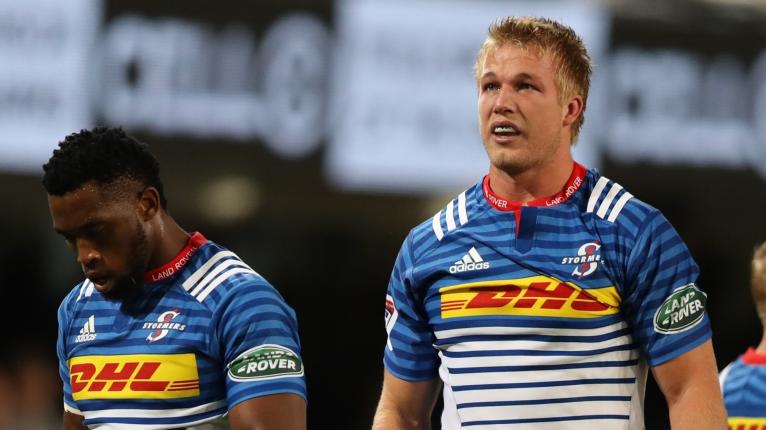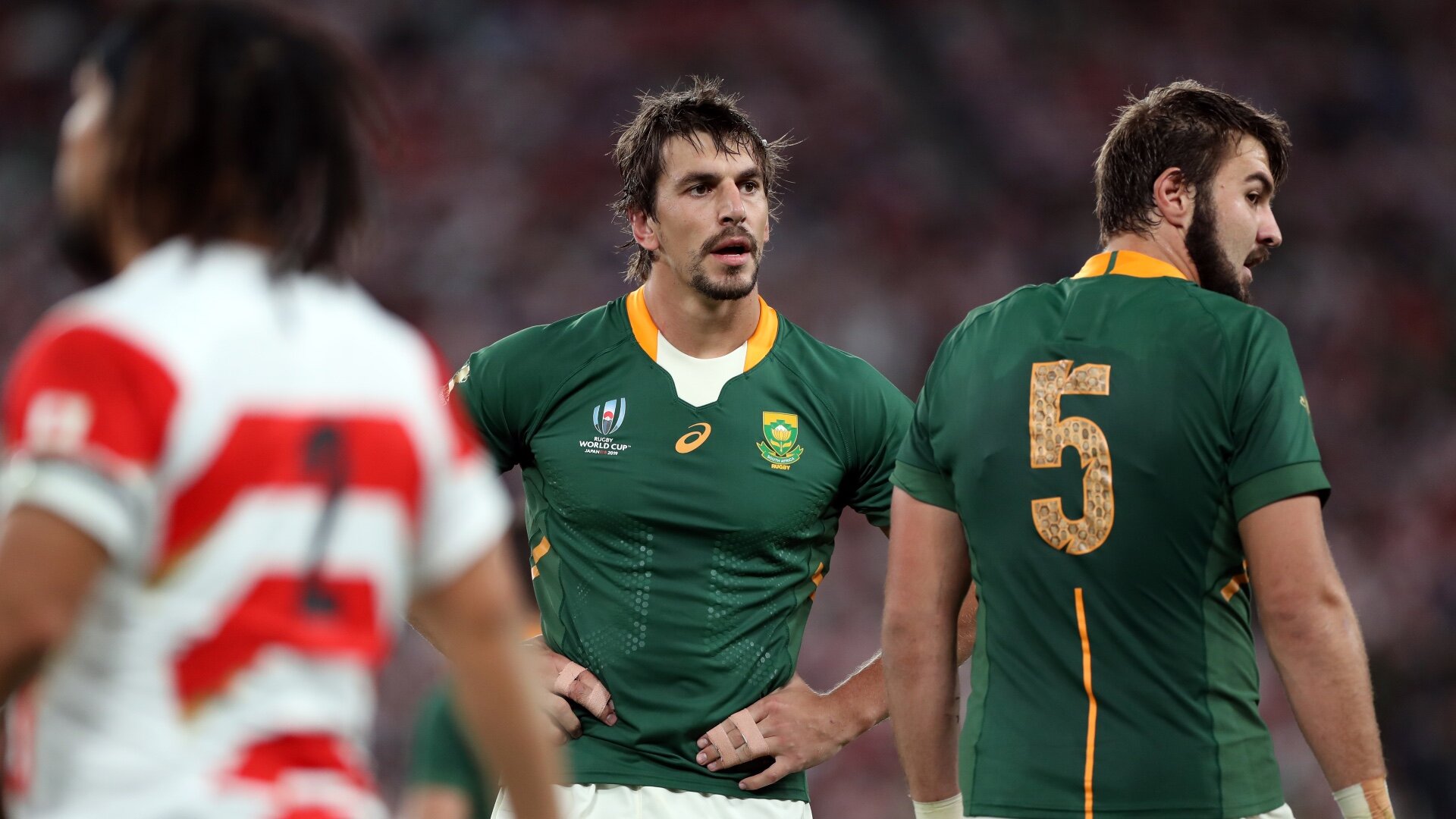The Springboks were top of the world in 2019. How do they stay there in 2020?

The 2019 Rugby World Cup final feels a lifetime ago right now, but with rugby all over the globe screeching to a halt amid the COVID-19 outbreak, it could well be the last game Springbok fans get to see their team in for quite some time, with the 2020 season in tatters.
As stands, it looks as though the July internationals will not go ahead and the Rugby Championship, without significant global improvement in the pandemic, could also go unfulfilled this year. There are even suggestions that the November internationals in Europe could be under threat, with reports indicating Rugby Australia fears for their viability.
Continue reading below…
Watch: The Rugby Pod – Season 4 Episode 32
Regardless, it seems the earliest we could see the Springboks back in action is August, should the Rugby Championship be deemed safe enough to go ahead. Failing that it could be November, or worse yet, they could be mothballed for the entirety of 2020.
It leaves plenty of time to ponder the next steps that Rassie Erasmus might take in his evolution of the side, such as who remains a key member of the squad and forms part of the core for the next Rugby World Cup cycle, as well as identifying some of the players currently on the fringes who are in prime position to move into more integral roles.
A lot was made of England’s youthful age profile at the Rugby World Cup and there is optimism among that nation’s fans that they could be in an even stronger position in 2023, though South Africa’s squad wasn’t exactly knocking on the retirement door out in Japan, either.
In the pack, talismanic captain Siya Kolisi and reigning World Rugby Player of the Year Pieter-Steph du Toit will almost certainly retain their spots on the flanks, giving Erasmus continuity in performance, experience and leadership. The two loose forwards remain with the Stormers, too, ensuring that the access Erasmus has to them and their availability for the Boks is as good as it possibly can be.
There is no pressing need to reenergise the engine room, either, with the quartet of Eben Etzebeth, Franco Mostert, Lood de Jager and RG Snyman all still in their 20’s, although all four now, or will very soon, ply their trade in Europe and Erasmus could be keen to ensure there is at least one South African-based lock in his core group moving forward.
The more urgent selection calls come at No 8 and loosehead, where the 33-year-old Duane Vermeulen is unlikely to make the next Rugby World Cup and Tendai Mtawarira has departed for the US for the swansong of his career. Malcolm Marx will continue to push Bongi Mbonambi at hooker, though some fresh blood will also likely be needed at tighthead moving forward.
'My understanding, from conversations with people within the game, is that there are 3, possibly 4, Premiership Rugby clubs that are in genuine danger of going out of business in the next few months.'
– @samrobertsrugby on rugby's day of reckoning ???https://t.co/shERu4gV4S
— RugbyPass (@RugbyPass) April 1, 2020
Loosehead is a fairly simple calculation, where Steven Kitshoff has been preparing to replace Mtawarira for a number of years now, and his promotion to that role should create opportunities for the likes of Ox Nche and Thomas du Toit, unless the latter is moved back to his previous position of tighthead.
Moving du Toit back to tighthead might not be the worst idea, either, not only given his remarkable early promise at the position, but also that South Africa’s stock of purpose-built tightheads behind Frans Malherbe is not overly populous. Wilco Louw’s progress at Harlequins will be closely monitored, as will the Lions pair of Carlü Sadie and the raw but talented prospect that is Asenathi Ntlabakanye.
Erasmus’ luxury contingent of locks allows him to be patient and slowly integrate players such as Salmaan Moerat, Ruan Nortjé and JJ van der Mescht at the position, should he want a domestically based player or two in the mix. All three boast unique talents and show that the pool of second rows in South Africa is a long way off drying up. Bishops student Connor Evans could yet even make his move on the position in a couple of seasons’ time.
The bigger question in the pack, outside of tighthead, is who will rise to the challenge of replacing the iconic Vermeulen at the base of the scrum. The Springboks have tried, and largely struggled, to do so in the past when domestic selection policies meant that the No 8 was unavailable during his stints in Japan.
Michael Fatialofa has spoken for the first time publicly about his catastrophic neck injury. https://t.co/RQGHTnz0Z0
— RugbyPass (@RugbyPass) April 1, 2020
South African rugby is rife with players of potential that can play the position, such as Juarno Augustus, Jaco Coetzee, Muller Uys and Phepsi Buthelezi, although precious few who have shown international standard at the senior level yet. Junior Pokomela is an intriguing option, although it remains to be seen if Erasmus will pick him whilst he is at the Cheetahs and not one of the South African Super Rugby franchises.
Loosehead and lock should take care of themselves, the hooker and flank stocks are in good shape and if some new talent can be found and nurtured at tighthead and No 8, there’s no reason to doubt that South Africa won’t be able to maintain their dominant and physical standards up front moving forward.
Their back line is in none too shabby shape, either, with Erasmus and the Boks relying on plenty of key players in Japan who should still be available in three years’ time in France.
In the half-backs, Faf de Klerk and Handré Pollard are going nowhere, whilst Herschel Jantjies looks to the manor born at scrum-half. Two players who might struggle a little more given their age to be in prime shape for the next Rugby World Cup are Cobus Reinach and Elton Jantjies, though with a bevvy of options at nine, finding competition for Pollard will be the real priority for Erasmus.
At centre, Frans Steyn will be moving on, but the trio of Damian de Allende, Lukhanyo Am and Jesse Kriel are all in or entering their primes, whilst the same can be said of the likes of Cheslin Kolbe, Sbu Nkosi and Warrick Gelant in the back three. At 30 years of age, Willie le Roux could face a sterner test against Father Time, as could the 29-year-old Makazole Mapimpi.
'We have entered the discussions with RUPA in good faith'https://t.co/dIR6hLuTpt
— RugbyPass (@RugbyPass) April 1, 2020
The search for competition for Pollard could begin and end with Curwin Bosch, with the impressive playmaker having come on significantly over the past 12 months. Damian Willemse could offer competition, too, although many have him slated as a better option to replace le Roux, where he would go head-to-head with Gelant for a spot. Bosch has become that consistent performer at the Super Rugby level and that is the next leap that Willemse needs to make to truly put a marker down for a regular Springbok jersey.
Two names to watch in the centres, eager to make the most of Steyn’s potential absence, are Rikus Pretorius and Wandisile Simelane. Hugely contrasting centres, Pretorius and Simelane are two of the standout performers at the U20 level for South Africa in recent years and the latter has begun to flash that ability for the Lions.
In the back three, the Sharks’ Aphelele Fassi has thrown his hat into the full-back mix with Willemse and Gelant, although with the proposed 50:22 kicking laws that could come in, having his counter-attacking and aerial ability on the wing rather than full-back wouldn’t be the worst move for Erasmus to make. Likewise, Tyrone Green is another that could be in the mix for any potential vacancies in the back three moving forward.

On the whole, it’s an encouraging period of transition for the Springboks, where there are very few positions that they feel undermanned in, in terms of prospective players pushing cases for selection. The tightheads and No 8s might lack somewhat for experience, though there is no dire need to move on from Malherbe or Vermeulen at this point and if the teams’ fortunes are going to be better served by keeping a number of the veterans in place for another season, Erasmus has the luxury to do just that.
Providing the potential financial ruin of COVID-19 doesn’t bring South African rugby to its knees, the Springboks look as though they are in a strong position to maintain their spot at the top of the world moving forward.
Watch: Could Australian rugby be about to lose another Super Rugby team?

























































